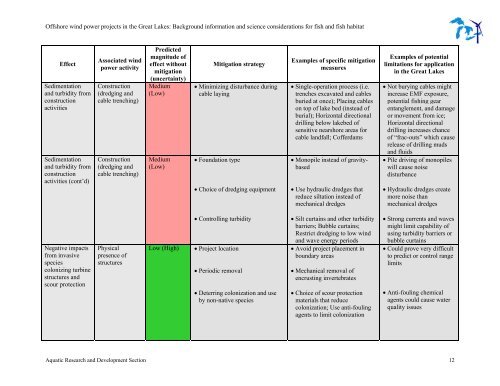Offshore Wind Power Projects in the Great Lakes - Ministry of ...
Offshore Wind Power Projects in the Great Lakes - Ministry of ...
Offshore Wind Power Projects in the Great Lakes - Ministry of ...
You also want an ePaper? Increase the reach of your titles
YUMPU automatically turns print PDFs into web optimized ePapers that Google loves.
<strong>Offshore</strong> w<strong>in</strong>d power projects <strong>in</strong> <strong>the</strong> <strong>Great</strong> <strong>Lakes</strong>: Background <strong>in</strong>formation and science considerations for fish and fish habitat<br />
Effect<br />
Sedimentation<br />
and turbidity from<br />
construction<br />
activities<br />
Sedimentation<br />
and turbidity from<br />
construction<br />
activities (cont’d)<br />
Negative impacts<br />
from <strong>in</strong>vasive<br />
species<br />
coloniz<strong>in</strong>g turb<strong>in</strong>e<br />
structures and<br />
scour protection<br />
Associated w<strong>in</strong>d<br />
power activity<br />
Construction<br />
(dredg<strong>in</strong>g and<br />
cable trench<strong>in</strong>g)<br />
Construction<br />
(dredg<strong>in</strong>g and<br />
cable trench<strong>in</strong>g)<br />
Physical<br />
presence <strong>of</strong><br />
structures<br />
Predicted<br />
magnitude <strong>of</strong><br />
effect without<br />
mitigation<br />
(uncerta<strong>in</strong>ty)<br />
Medium<br />
(Low)<br />
Medium<br />
(Low)<br />
Mitigation strategy<br />
• M<strong>in</strong>imiz<strong>in</strong>g disturbance dur<strong>in</strong>g<br />
cable lay<strong>in</strong>g<br />
• Foundation type<br />
• Choice <strong>of</strong> dredg<strong>in</strong>g equipment<br />
• Controll<strong>in</strong>g turbidity<br />
Low (High) • Project location<br />
• Periodic removal<br />
• Deterr<strong>in</strong>g colonization and use<br />
by non-native species<br />
Examples <strong>of</strong> specific mitigation<br />
measures<br />
• S<strong>in</strong>gle-operation process (i.e.<br />
trenches excavated and cables<br />
buried at once); Plac<strong>in</strong>g cables<br />
on top <strong>of</strong> lake bed (<strong>in</strong>stead <strong>of</strong><br />
burial); Horizontal directional<br />
drill<strong>in</strong>g below lakebed <strong>of</strong><br />
sensitive nearshore areas for<br />
cable landfall; C<strong>of</strong>ferdams<br />
• Monopile <strong>in</strong>stead <strong>of</strong> gravitybased<br />
• Use hydraulic dredges that<br />
reduce siltation <strong>in</strong>stead <strong>of</strong><br />
mechanical dredges<br />
• Silt curta<strong>in</strong>s and o<strong>the</strong>r turbidity<br />
barriers; Bubble curta<strong>in</strong>s;<br />
Restrict dredg<strong>in</strong>g to low w<strong>in</strong>d<br />
and wave energy periods<br />
• Avoid project placement <strong>in</strong><br />
boundary areas<br />
• Mechanical removal <strong>of</strong><br />
encrust<strong>in</strong>g <strong>in</strong>vertebrates<br />
• Choice <strong>of</strong> scour protection<br />
materials that reduce<br />
colonization; Use anti-foul<strong>in</strong>g<br />
agents to limit colonization<br />
Examples <strong>of</strong> potential<br />
limitations for application<br />
<strong>in</strong> <strong>the</strong> <strong>Great</strong> <strong>Lakes</strong><br />
• Not bury<strong>in</strong>g cables might<br />
<strong>in</strong>crease EMF exposure,<br />
potential fish<strong>in</strong>g gear<br />
entanglement, and damage<br />
or movement from ice;<br />
Horizontal directional<br />
drill<strong>in</strong>g <strong>in</strong>creases chance<br />
<strong>of</strong> “frac-outs” which cause<br />
release <strong>of</strong> drill<strong>in</strong>g muds<br />
and fluids<br />
• Pile driv<strong>in</strong>g <strong>of</strong> monopiles<br />
will cause noise<br />
disturbance<br />
• Hydraulic dredges create<br />
more noise than<br />
mechanical dredges<br />
• Strong currents and waves<br />
might limit capability <strong>of</strong><br />
us<strong>in</strong>g turbidity barriers or<br />
bubble curta<strong>in</strong>s<br />
• Could prove very difficult<br />
to predict or control range<br />
limits<br />
• Anti-foul<strong>in</strong>g chemical<br />
agents could cause water<br />
quality issues<br />
Aquatic Research and Development Section 12
















